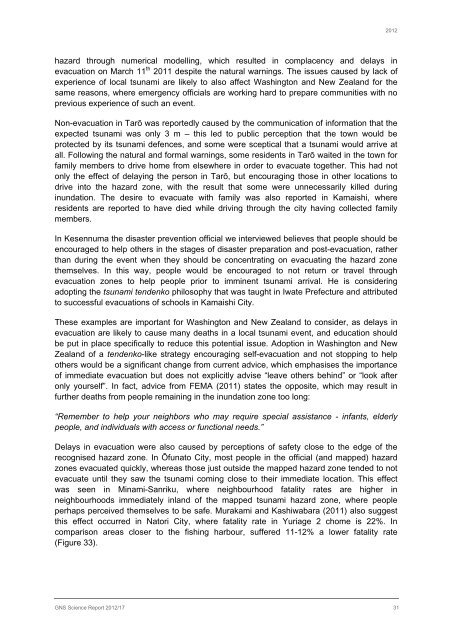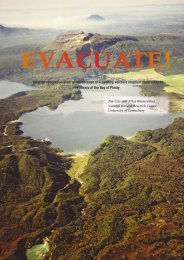Tsunami evacuation: Lessons from the Great East Japan earthquake ...
Tsunami evacuation: Lessons from the Great East Japan earthquake ...
Tsunami evacuation: Lessons from the Great East Japan earthquake ...
You also want an ePaper? Increase the reach of your titles
YUMPU automatically turns print PDFs into web optimized ePapers that Google loves.
2012<br />
hazard through numerical modelling, which resulted in complacency and delays in<br />
<strong>evacuation</strong> on March 11 th 2011 despite <strong>the</strong> natural warnings. The issues caused by lack of<br />
experience of local tsunami are likely to also affect Washington and New Zealand for <strong>the</strong><br />
same reasons, where emergency officials are working hard to prepare communities with no<br />
previous experience of such an event.<br />
Non-<strong>evacuation</strong> in Tarō was reportedly caused by <strong>the</strong> communication of information that <strong>the</strong><br />
expected tsunami was only 3 m – this led to public perception that <strong>the</strong> town would be<br />
protected by its tsunami defences, and some were sceptical that a tsunami would arrive at<br />
all. Following <strong>the</strong> natural and formal warnings, some residents in Tarō waited in <strong>the</strong> town for<br />
family members to drive home <strong>from</strong> elsewhere in order to evacuate toge<strong>the</strong>r. This had not<br />
only <strong>the</strong> effect of delaying <strong>the</strong> person in Tarō, but encouraging those in o<strong>the</strong>r locations to<br />
drive into <strong>the</strong> hazard zone, with <strong>the</strong> result that some were unnecessarily killed during<br />
inundation. The desire to evacuate with family was also reported in Kamaishi, where<br />
residents are reported to have died while driving through <strong>the</strong> city having collected family<br />
members.<br />
In Kesennuma <strong>the</strong> disaster prevention official we interviewed believes that people should be<br />
encouraged to help o<strong>the</strong>rs in <strong>the</strong> stages of disaster preparation and post-<strong>evacuation</strong>, ra<strong>the</strong>r<br />
than during <strong>the</strong> event when <strong>the</strong>y should be concentrating on evacuating <strong>the</strong> hazard zone<br />
<strong>the</strong>mselves. In this way, people would be encouraged to not return or travel through<br />
<strong>evacuation</strong> zones to help people prior to imminent tsunami arrival. He is considering<br />
adopting <strong>the</strong> tsunami tendenko philosophy that was taught in Iwate Prefecture and attributed<br />
to successful <strong>evacuation</strong>s of schools in Kamaishi City.<br />
These examples are important for Washington and New Zealand to consider, as delays in<br />
<strong>evacuation</strong> are likely to cause many deaths in a local tsunami event, and education should<br />
be put in place specifically to reduce this potential issue. Adoption in Washington and New<br />
Zealand of a tendenko-like strategy encouraging self-<strong>evacuation</strong> and not stopping to help<br />
o<strong>the</strong>rs would be a significant change <strong>from</strong> current advice, which emphasises <strong>the</strong> importance<br />
of immediate <strong>evacuation</strong> but does not explicitly advise “leave o<strong>the</strong>rs behind” or “look after<br />
only yourself”. In fact, advice <strong>from</strong> FEMA (2011) states <strong>the</strong> opposite, which may result in<br />
fur<strong>the</strong>r deaths <strong>from</strong> people remaining in <strong>the</strong> inundation zone too long:<br />
“Remember to help your neighbors who may require special assistance - infants, elderly<br />
people, and individuals with access or functional needs.”<br />
Delays in <strong>evacuation</strong> were also caused by perceptions of safety close to <strong>the</strong> edge of <strong>the</strong><br />
recognised hazard zone. In Ōfunato City, most people in <strong>the</strong> official (and mapped) hazard<br />
zones evacuated quickly, whereas those just outside <strong>the</strong> mapped hazard zone tended to not<br />
evacuate until <strong>the</strong>y saw <strong>the</strong> tsunami coming close to <strong>the</strong>ir immediate location. This effect<br />
was seen in Minami-Sanriku, where neighbourhood fatality rates are higher in<br />
neighbourhoods immediately inland of <strong>the</strong> mapped tsunami hazard zone, where people<br />
perhaps perceived <strong>the</strong>mselves to be safe. Murakami and Kashiwabara (2011) also suggest<br />
this effect occurred in Natori City, where fatality rate in Yuriage 2 chome is 22%. In<br />
comparison areas closer to <strong>the</strong> fishing harbour, suffered 11-12% a lower fatality rate<br />
(Figure 33).<br />
GNS Science Report 2012/17 31

















